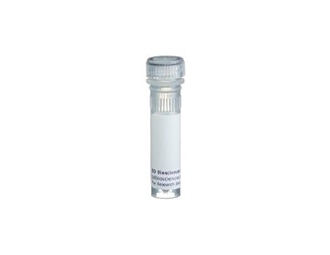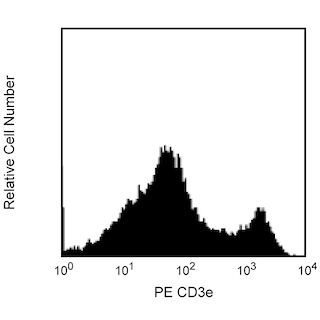Old Browser
Looks like you're visiting us from {countryName}.
Would you like to stay on the current country site or be switched to your country?




Two-color analysis of the expression of CD40 on mouse spleen cells. BALB/c splenocytes were simultaneously stained with PE-conjugated anti-mouse CD3e mAb 145-2C11 (Cat. No. 553063) and biotinylated mAb 3/23 (right panel), followed by Avidin-FITC (Cat. No. 554057). Please note that staining of a T-cell subset by mAb 3/23 has not been consistently observed. Flow cytometry was performed on a BD FACScan™ flow cytometry system.


BD Pharmingen™ Biotin Rat Anti-Mouse CD40

Regulatory Status Legend
Any use of products other than the permitted use without the express written authorization of Becton, Dickinson and Company is strictly prohibited.
Preparation And Storage
Product Notices
- Since applications vary, each investigator should titrate the reagent to obtain optimal results.
- Please refer to www.bdbiosciences.com/us/s/resources for technical protocols.
- Caution: Sodium azide yields highly toxic hydrazoic acid under acidic conditions. Dilute azide compounds in running water before discarding to avoid accumulation of potentially explosive deposits in plumbing.
Companion Products


.png?imwidth=320)
The 3/23 clone monoclonal antibody specifically binds to CD40, a 40-50 kDa glycoprotein expressed on B lymphocytes and other antigen-presenting cells. CD40 has been reported to be transiently expressed on activated CD4+ and CD8+ T cells and in some mouse strains, the 3/23 mAb has been reported to react with 5-10% of T lymphocytes in adult mouse, but not neonatal, spleen. CD40 plays a key role in B-cell growth and differentiation where interactions of CD40 with its ligand, CD154, are involved in the initiation, effector, and memory stages of cell-mediated immune responses. In addition, CD40 has been reported to be involved with the triggering of NK cells and NK-T cells. Ligation of CD40 with the 3/23 antibody has been reported to induce splenic B cells to express the costimulatory molecule CD86 (B7-2). In addition, although the 3/23 antibody by itself is a weak B-cell mitogen, it has been reported to synergize markedly with mitogenic anti-IgM, anti-IgD mAb or IL-4 to promote B-cell proliferation.
This antibody is routinely tested by flow cytometric analysis. Other applications were tested at BD Biosciences Pharmingen during antibody development only or reported in the literature.
Development References (13)
-
Bourgeois C, Rocha B, Tanchot C. A role for CD40 expression on CD8+ T cells in the generation of CD8+ T cell memory. Science. 2002; 297(5589):2060-2063. (Biology). View Reference
-
Grewal IS, Flavell RA. CD40 and CD154 in cell-mediated immunity. Annu Rev Immunol. 1998; 16:111-135. (Biology). View Reference
-
Hasbold J, Johnson-Leger C, Atkins CJ, Clark EA, Klaus GG. Properties of mouse CD40: cellular distribution of CD40 and B cell activation by monoclonal anti-mouse CD40 antibodies. Eur J Immunol. 1994; 24(8):1835-1842. (Immunogen: Activation, (Co)-stimulation). View Reference
-
Hasbold J, Klaus GG. B cells from CBA/N mice do not proliferate following ligation of CD40. Eur J Immunol. 1994; 24(1):152-157. (Biology: Activation, (Co)-stimulation). View Reference
-
Klaus GG, Holman M, Hasbold J. Properties of mouse CD40: the role of homotypic adhesion in the activation of B cells via CD40. Eur J Immunol. 1994; 24(11):2714-2719. (Biology). View Reference
-
Leifeld L, Trautwein C, Dumoulin FL, Manns MP, Sauerbruch T, Spengler U. Enhanced expression of CD80 (B7-1), CD86 (B7-2), and CD40 and their ligands CD28 and CD154 in fulminant hepatic failure. Am J Pathol. 1999; 154(6):1711-1720. (Biology). View Reference
-
Mahnke K, Becher P, Ricciardi-Castagnoli P, Luger TA, Schawrz T Grabbe S. CD14 is expressed by subsets of murine dendritic cells and upregulated by lipopolysaccharide. In: Ricciardi-Castagnoli P, ed. Dendritic Cells in Fundamental and Clinical Immunology. New York: Plenum Press; 1997:145-159.
-
Munder M, Mallo M, Eichmann K, Modolell M. Murine macrophages secrete interferon gamma upon combined stimulation with interleukin (IL)-12 and IL-18: A novel pathway of autocrine macrophage activation. J Exp Med. 1998; 187(12):2103-2108. (Biology). View Reference
-
Noelle RJ, Ledbetter JA, Aruffo A. CD40 and its ligand, an essential ligand-receptor pair for thymus-dependent B-cell activation. Immunol Today. 1992; 13(11):431-433. (Biology). View Reference
-
Parry SL, Hasbold J, Holman M, Klaus GG. Hypercross-linking surface IgM or IgD receptors on mature B cells induces apoptosis that is reversed by costimulation with IL-4 and anti-CD40. J Immunol. 1994; 152(6):2821-2829. (Biology). View Reference
-
Parry SL, Holman MJ, Hasbold J, Klaus GG. Plastic-immobilized anti-mu or anti-delta antibodies induce apoptosis in mature murine B lymphocytes. Eur J Immunol. 1994; 24(4):974-979. (Biology). View Reference
-
Tomura M, Yu WG, Ahn HJ, et al. A novel function of Valpha14+CD4+NKT cells: stimulation of IL-12 production by antigen-presenting cells in the innate immune system. J Immunol. 1999; 163(1):93-101. (Biology). View Reference
-
Turner JG, Rakhmilevich AL, Burdelya L, et al. Anti-CD40 antibody induces antitumor and antimetastatic effects: the role of NK cells. J Immunol. 2001; 166(1):89-94. (Biology). View Reference
Please refer to Support Documents for Quality Certificates
Global - Refer to manufacturer's instructions for use and related User Manuals and Technical data sheets before using this products as described
Comparisons, where applicable, are made against older BD Technology, manual methods or are general performance claims. Comparisons are not made against non-BD technologies, unless otherwise noted.
For Research Use Only. Not for use in diagnostic or therapeutic procedures.
Report a Site Issue
This form is intended to help us improve our website experience. For other support, please visit our Contact Us page.